Abstract
The T35 Medical Student Research Training Program (MSRTP), funded by NIDDK, is an intensive, mentored research training program for first year medical students. Here, we describe the program, demographics, and short-term outcomes from 2019-2022. A single institution hosted 63 students from 19 national medical schools and paired them with NIDDK funded mentors. 100% of mentors’ responses and 98% of students’ responses met or exceeded expectations for all MSRTP’s core objectives. All students reported that MSRTP was important for their career development. The MSRTP is an important training program that can potentially accelerate research and innovation in NIDDK’s mission areas.
Keywords
Education, Evaluation, National Institute of Diabetes and Digestive and Kidney Diseases (NIDDK), Medical student, Research, Training program.
Introduction
Approximately 11.3% of the US population are diabetic, 29% are prediabetic, and 41.9% have obesity [1]. Research and development in these National Institute of Diabetes and Digestive and Kidney Diseases (NIDDK) mission areas are critical and the momentum following the approval of several blockbuster drugs, innovations, and technologic advances must continue. With rising development costs and a decreasing number of physician-scientists nationally, there is an immediate need to reinvigorate early-stage researchers and medical students [2-4].
Research is an integral part of a medical student’s career development that enables them to build connections, learn from colleagues and mentors, hone their statistical, analytical, presentation, and writing skills, and better understand how to formulate impactful research questions. Medical students who participate in research are more likely to stay involved in research, more adept at applying emerging knowledge to patient care, and are highly motivated to present their research and participate in publications [5,6]. Furthermore, most US medical schools have a research requirement; students and residency directors believe that research is an important element of residency applications [7-10].
The NIDDK supports the T35 Medical Student Research Training Program (MSRTP) at a top US medical school. MSRTP accepts 20-24 medical students per year to spend 9 weeks with an NIDDK funded mentor after their first year of medical school. The purpose of MSRTP is to provide medical students with an intense and rigorous exposure to biomedical research in areas relevant to the NIDDK in a program structured to provide practical support and foster excitement about research. Other targeted training programs for early-stage researchers have resulted in increased competency and knowledge gained in NIDDK priority areas [11,12]. Here, we describe the program, demographics and short-term effectiveness from 2019-2022.
Materials and Methods
Program Description
The T35 MSRTP is a 9-week program that runs from June through August at a top US medical institution in New York City. Students who have completed their first year of medical school at an Accreditation Council for Graduate Medical Education (ACGME) accredited institution are eligible to apply.
Core operational aims are to:
- Provide exceptional mentors and exciting projects.
- Identify highly qualified students and optimize the probability that their work will lead to publication in high impact journals.
- Create a cohesive and collaborative environment among medical students and different mentors.
- Obtain data to evaluate success of the program and allow for improvement.
After completion of the program, students should be able to
- Critically review research papers
- Design a realistic and specific research proposal
- Follow lab methods, procedures, and techniques
- Demonstrate professionalism by participation in the intellectual life of the lab, respectful and helpful activities, and ethical decision-making
- Demonstrate strong written and oral communication skills by writing clear, concise abstracts, proposals, and papers, and speaking clearly and precisely during talks, group meetings, presentations, and poster sessions.
Application and Enrollment
Prior to medical students’ recruitment, all NIDDK funded Principal Investigators at the host institution are given an opportunity to apply to be a mentor in the MSRTP. Mentors are then carefully chosen by the program director as demonstrated by a strong mentoring track record as well as involvement in highly relevant research projects. A project and mentor list is created, posted on the university’s website, and dispersed to national medical schools (Table 1). Potential trainees contact mentors with projects of interest; there is an interview process that culminates with selection of 1-2 students per project. After program director approval, accepted students submit a research proposal. To increase the probability that selected projects will lead to student led publications, an updated research plan is required prior to start.
Project Title |
Description of Project |
Characterization of post-ingestive sugar sensor in the brain of flies |
|
BRinging the Diabetes Prevention Program to GEriatric populations (BRIDGE) |
We showed that taste-blind mutants still prefer a sugar solution based on its nutritional content after starvation and identified a candidate sensor that detects the nutritional value of sugar. The project is to characterize the function of the sensor. |
Alterations in choline gene expression in antibiotic-treated mice |
From metagenomic sequencing of fecal specimens obtained from antibiotic-treated and control mice, we have 300 GB of sequence. We will perform informatic searches of bacterial genes involved in choline metabolism to determine whether antibiotic treatments affect the major pathways. |
Machine learning based tool for automatic lower extremity image segmentation |
There are currently no available tools to automatically identify muscle groups, bone, and peripheral adipose tissue in lower extremity MR images, which necessitates burdensome and variable manual analysis. The student will work toward addressing this issue by expanding our training dataset and working with our machine-learning team to create and validate a customized convolutional neural network, which will be utilized in a wide range of MRI projects including our clinical trial on exercise intervention in diabetic peripheral neuropathy. |
Role of adenosine receptors in promoting fat browning |
We are examining the effect of local and systemic administration of agents that, directly or indirectly, stimulate adenosine A2A receptors in adipose tissue on the formation of brown fat (fat cells with increased mitochondria that actually burn energy) from white adipose tissue as well as regulation of macrophage function and phenotype in adipose tissue.
|
Impact of the built environment on child Body Mass Index |
This project combines multiple rich datasets to determine the influence of the built environment on
childhood obesity in New York City. In particular, features of small areas around each child’s home and school, as well as the characteristics of their home and school buildings, are being examined. |
CRAC channels in Th1 and Th17 cells as mediators of colitis and therapeutic targets |
The overall goal of this project is to understand the role of Ca2+ influx mediated by Ca2+ release activated Ca2+ (CRAC) channels in the proinflammatory function of Th17 and Th1 cells and how they control autoimmunity in IBD. Elucidating how SOCE regulates the colitogenic function of T cells will allow us to assess the benefits and risks associated with CRAC channel inhibition as a potent immunosuppressive treatment for IBD. |
Testing the efficacy of a technology-assisted weight management intervention within patient-centered medical homes: The GEM (Goals for Eating and Moving) study |
The Goals for Eating and Moving (GEM) Study tests the efficacy of a technology-assisted health coaching intervention over 12 months to improve weight management in primary care at the Manhattan VA. Students will have the opportunity to gain experience and help with recruitment and retention, data collection and management, as well as being involved in the planning and implementation of RE-AIM (Reach, Effectiveness, Adoption, Implementation, Maintenance) data collection and mixed-methods data analysis. |
VLDL overproduction in insulin resistance and the role of the insulin-mediated degradation of apoB100 via autophagy |
The overall goal of the project is to obtain detailed understanding of dyslipidemia in insulin resistance (IR) and diabetes (DM). People with IR and DM oversecrete VLDL from the liver, which leads to high triglyceride and low HDL levels. Specifically, the student will extend our recent discovery that under normal circumstances, insulin can promote the autophagic degradation of partially assembled VLDL particles prior to their secretion by the liver. If this degradation pathway is impaired in IR/DM, it would result in VLDL over secretion. |
Fluorescent tracking of exogenously delivered oxytocin |
The neuropeptide oxytocin is increasingly explored as a potential therapy for the social deficit symptoms of autism spectrum disorder (ASD), but the mechanisms of action and where administered oxytocin goes in the brain is not well understood. We propose to use a fluorescent labeling approach to track where exogenous oxytocin localizes in the brain. |
BEEP evaluation and dissemination |
The Biomedical Entrepreneurship Educational Program (BEEP) trains students in Biomedical Entrepreneurship, with a special focus on diabetes, obesity and metabolic diseases, now in year 3. The program aims to expand the skill set of scientists and clinicians who are interested in actively participating in the commercialization of academic discoveries and inventions so they can become successful entrepreneurs in the biomedical industry and bring much needed therapies to market; T35 mentees will work with evaluation team to analyze student surveys and outcomes and prepare manuscripts, media posts, ebooks, modules for dissemination. |
A mobile health Intervention to reduce diabetes disparities in Chinese Americans |
This project aims to recruit patients only and to examine the potential efficacy of a social media-based diabetes intervention to lower blood sugar in Chinese Americans and immigrants with type 2 diabetes (T2D). |
DREAM intervention – An intervention to prevent and manage diabetes among South Asians in New York City |
The fellow will work on analyses of fidelity as well as collection and coding of implementation data for the DREAM intervention – an intervention to prevent and manage diabetes among South Asians in New York City. As part of the fidelity evaluation, the fellow will examine data in our online research database related to in-person and virtual intervention components including the transition to remote context because of the COVID-19 pandemic. As part of the annual implementation evaluation, the fellow will conduct qualitative interviews with research program staff, community health workers (CHWs), and community partners to assess barriers and facilitators to intervention implementation. The fellow will also assist with coding interviews as well as development of abstracts, presentations, and manuscript preparation based on the results of this project. |
The Retrain Your Brain for Healthy Eating Study |
The aim of this mixed methods study is to evaluate the feasibility of a food response training (FRT) intervention, a novel behavioral strategy, to reduce unhealthy dietary intake in diverse patients with obesity. FRT targets automatic processes in the food reward system to help patients who might not respond to traditional behavioral interventions. We will evaluate FRT’s effects on diet, weight and clinical outcomes and explore factors (environmental and genetic) associated with response to FRT. This study will be conducted among 60 patients with obesity recruited from NYU Langone Health. Measurements will occur at baseline and at three months follow-up. For a subgroup of participants, we will collect saliva samples for genetic analysis at baseline assessment (ancillary study). |
Data analysis of high dimensional microbiome/metagenomic data |
In this coming year, my lab is interested in analyzing three longitudinal Integrative Human Microbiome Project (https://hmpdacc.org/ihmp/) cohorts, focusing on the interaction between host and microbiome over time in three conditions: pregnancy and preterm birth, inflammatory bowel disease (IBD), and progression to type 2 diabetes (T2D). Two challenging features we need to deal with using the advanced statistical methods are 1) longitudinal microbiome sampling and survival outcome; and 2) high‐dimensional, longitudinal measurements of multiple molecules (metabolites, genes, and proteins) in both host and microbiome from the same sets of samples. |
Amplifying provider impact on patient engagement with an EHR- integrated digital diabetes prevention program (dDPP) |
This study seeks to set the standard for how data from new digital behavior change interventions are integrated into the EHR and clinical workflow. This tool pushes key dDPP data elements (ex. weight and daily step count) directly into EHR workflows of primary care to enhance patient engagement. It seeks to determine the impact of combining adapted visualizations and summaries of key dDPP data elements directly into the EHR with automated notifications and messaging designed to enhance patient engagement in the dDPP. The study involves provider workflow analysis based on observation and facilitated group tool adaptation sessions. Ongoing activities include piloting of the new tool within the NYU Langone ambulatory primary care network and partnering with digital health companies to determine best practices. |
Transcriptional regulation of adipocyte function and energy balance |
Understanding the transcriptional networks that govern lipid storage and calorie utilization in all adipocyte types in response to intrinsic and extrinsic signals. |
Direct regulation of hexokinase by Ras |
Glucose metabolism is altered in cancer cells, but the mechanisms are poorly understood. We have discovered a direct interaction between the most important human oncogene, Ras, and hexokinase, the first enzyme in the glycolytic pathway that phosphorylated glucose. The project available will utilize biochemical methods such as co-immunoprecipitation to characterize the molecular interaction between Ras and hexokinase. |
Role of resident macrophages in re-vascularization following ischemic injury |
Using genetically modified mice models of resident and monocyte-derived macrophages to investigate their respective roles in assisting re-vascularization in a mouse model of peripheral artery disease (Critical Limb Ischemia (CLI). |
The role of RAGE in diet induced obesity |
RAGE and its ligands are highly expressed in the adipose and liver tissue of mice fed for two weeks with a high fat diet, that is, a time prior to the development of obesity, and RAGE null mice are protected from diet induced obesity. The goal of the project is to use mice with conditional cell specific deletion of RAGE to test the hypothesis that both inflammatory and adipocyte specific signals mediate RAGE-dependent development of obesity and metabolic dysfunction in mice fed a high fat diet. |
Table 1. Selected NIDDK T35 MSRTP Projects (20) from 2019-2022
Program Deliverables and Structure
Deliverables include:
- student attendance at all didactic sessions, seminars, and journal clubs
- regular meetings with mentor
- submission of an abstract or publication
- submission of a post-program progress report
- completion of a post-program survey.
Mentors and students create individual work plans including research activities, meetings, deadlines, and check-ins. During the first two weeks of the program, students attend didactic sessions on scientific integrity and responsible conduct of research, lab techniques, lab safety training, and how to present and discuss peer reviewed articles. Students attend weekly journal clubs; each student presents an article of interest from a high impact journal to further refine their knowledge of novel scientific research. Weekly Translational Research In Progress (TRIP) seminars where faculty discuss current research, challenges, and successes are also attended by MSRTP students.
Demographics
Demographic data assessed included gender, race, ethnicity, and self-identification as underrepresented in science and medicine (URiM).
Program evaluation
To ascertain core operational objectives, students and mentors completed a post-program survey. Core objectives were rated as either below expectations, meets expectations, or exceeded expectations and are as follows:
- I designed a research proposal that had specific aims and realistic procedures to test the hypothesis.
- I understand the fundamental problem motivating this area of research and the importance of the project.
- I have attained strong lab skills. I am familiar with the lab equipment, and I follow procedures and techniques well.
- I can read and understand basic science research papers.
- I demonstrated respect for and willingness to help others in the lab.
- I communicated well. My colleagues understood my thoughts and ideas when I spoke or wrote emails, papers, and posters.
- I actively participated in the intellectual life of the lab by taking an interest in others' works, participating in laboratory meetings, laboratory journal clubs, and departmental seminars.
- I sought sufficient guidance from my mentor.
Also included were questions specific to MSRTP’s potential career development impact and usefulness.
Free-responses questions included:
- Do you intend to continue working on this project?
- Identify strengths that contributed to your research experience.
- Identify areas that you would like to focus on improving.
- Identify specific tasks you may do to improve your skills.
- Explain your plans for presentation or publication of your work.
- Other comments useful to continuing programmatic refinement.
Results
Program Demographics
From 2019-2022, 63 students representing 19 medical schools and 37 mentors participated in the MSRTP. There were 64, 65, 67, and 73 different projects offered in 2019, 2020, 2021, and 2022 respectively. MSRTP hosted 5 students in 2019, 18 in 2020, 20 in 2021, and 20 in 2022. The majority of students identified as female (64%) and 21% identified as URiM. Of the 37 mentors, 51% were male, 49% female, and 8% identified as URiM. From 2019-2022, 25 mentors participated in the MSRTP for one year, 7 for two years, and 5 for three years. 15 mentors had terminal degrees of MD, 18 PhD, 3 MD/PhD, and 1 ScD. Most mentors hosted one student, 7 mentors hosted two students, 2 mentors hosted three students, and 3 students were hosted by two mentors.
Program Evaluation
Post-Program Surveys 2019-2022: 100% of students and 59% of mentors completed the survey. 100% of mentor responses either met or exceeded expectations. 98% of students' responses for all core objectives either met or exceeded expectations. 50% of students’ responses for all core objectives exceeded expectations in 2019, 58% in 2020, 59% in 2021, and 61% in 2022 [Figure 1 (A,B,C,D,E,F)]. All students stated that MSRTP was useful to some degree or to a great degree in terms of career development [Figure 2A]. 74% of students stated that their MSRTP experience encouraged them to pursue basic science research [Figure 2B], while 13% stated that they did not want to pursue further scientific research [Figure 2C]. 80% of students stated they plan to continue working on their project, 62% had plans for an abstract or publication and 20% already submitted an abstract or manuscript.
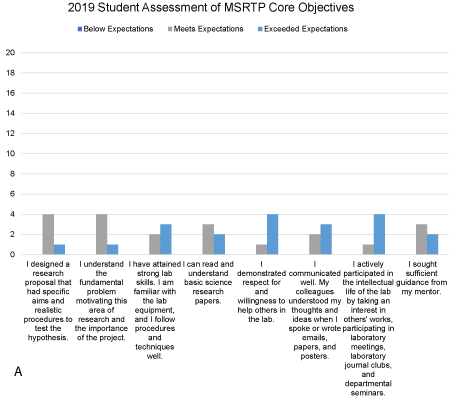
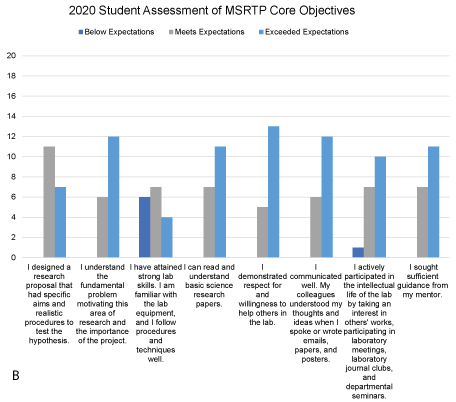
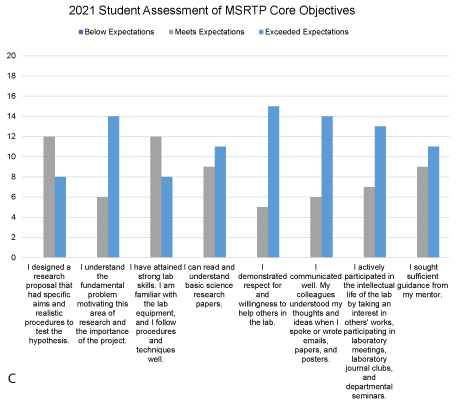
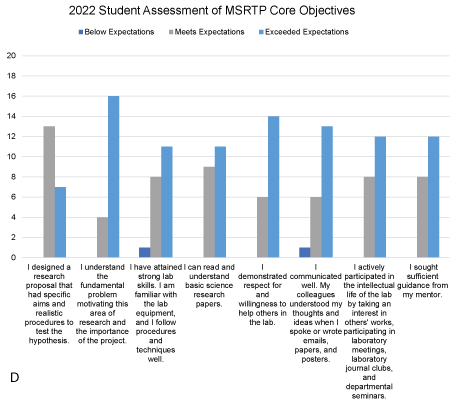
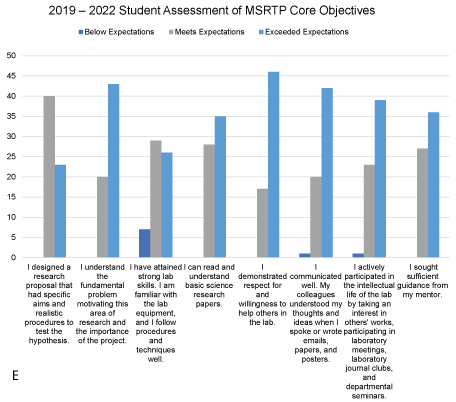
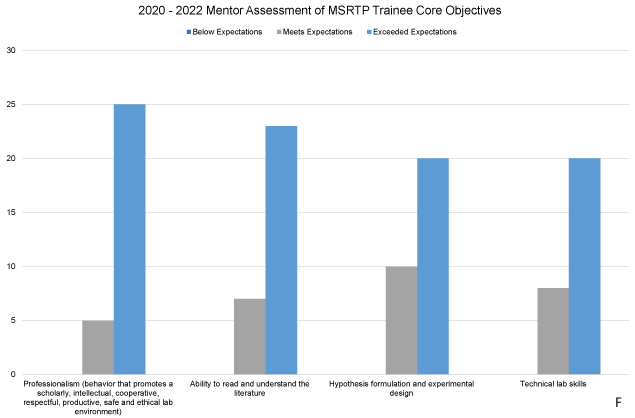
Table 1. Selected NIDDK T35 MSRTP Projects (20) from 2019-2022
Figure 1. Assessment of MSRTP core objectives, either below, meets, or exceeds expectations, by (A) 2019 Students; (B) 2020 Students; (C) 2021 Students; (D) 2022 Students; (E) 2019-2022 Students; (F) 2020-2022 Mentors
- (A). 2019 Students.
- (B). 2020 Students.
- (C). 2021 Students.
- (D). 2022 Students.
- (E). 2019-2022 Students.
- (F). 2020-2022 Mentors.
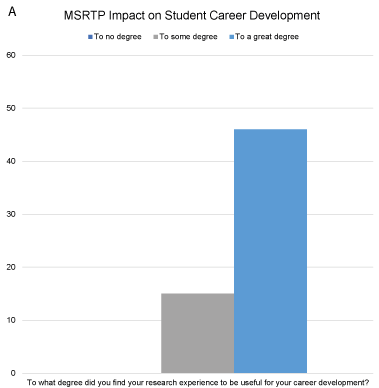
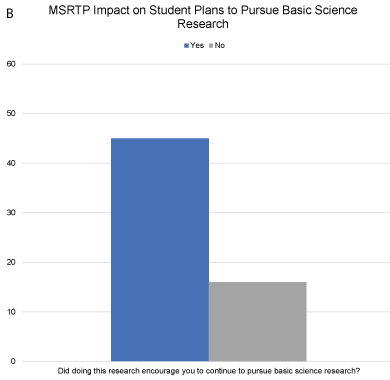

Figure 2. Assessment of MSRTP Impact on Student’s (A) Career Development (B) Plans to Pursue Basic Science Research (C) No Plans to Pursue Scientific Research
- (A). either to no degree, to some degree or to a great degree if MSRTP was useful toward career development.
- (B). either yes or no, if MSRTP impacted their plans to pursue basic science research.
- (C). either yes or no, if MSRTP impacted their plans not to pursue scientific research
Free-response answers
70% of students referenced having a strong research team and knowledgeable mentors as being crucial factors of MSRTP success. In terms of further skills improvement, 51% of students mentioned review of relevant scientific literature, 25% mentioned statistical and data analysis techniques, 17% mentioned scientific writing, 14% mentioned laboratory techniques, and 10% mentioned public speaking.
Select student and mentor comments:
- “MSRTP was an enjoyable program with mentorship that exceeded my expectations in all aspects. I will continue to do basic and clinical research.”
- “MSRTP was a great opportunity to do research focused on my career goals, meet students in a similar path, and learn first-hand basic research skills.”
- “I believe MSRTP will be very beneficial to me in my career as a physician-researcher.”
- “I'm proud to participate in the development of future physician researchers.”
- “Student was a perfect fit for my NIDDK funded research. Brilliant, motivated, and passionate about the field.”
- “Student was outstanding, they clearly understood the project, performed experiments diligently, and organized all the data perfectly.”
Discussion
The MSRTP attracts motivated and passionate medical students from a variety of backgrounds and geographic regions. Of the 63 students, 21% identified as URiM and 64% were female. Therefore, MSRTP successfully recruited and trained early-stage researchers who are underrepresented in science and medicine. MSRTP mentors work on a wide assortment of projects within different career trajectories. The diverse representation of students and mentors enabled a wealth of viewpoints to be shared.
Students met core objectives across all years evaluated. The high ratings by both mentors and students in key proficiency domains reflect short-term success of MSRTP in providing relevant training to students in the methods of scientific research. All students stated that their MSRTP experience was useful for their career development. The vast majority of students stated that their experience led them to pursue further scientific research. Therefore, MSRTP helps to instill a passion for scientific research in critical disease areas such as diabetes and obesity and empowers students to partake in relevant projects.
Students mentioned their desire to improve skills in literature review, statistical analysis, and lab techniques, consistent with ratings in these domains. Students who conducted basic research felt that MSRTP exceeded expectations in lab techniques, but expectations were lower in understanding of scientific papers and data analysis. Whereas students who worked on clinical, educational, or population health research had the opposite experience. Most students reported an interest in exploring other aspects of research (basic or clinical) in the future. This was particularly important during 2020 when many labs transitioned to remote work and decentralization and altered their research focus due to the COVID-19 pandemic. Student self-assessment of lab technique was much lower that year, 33% were below expectations in 2020, whereas in 2019 and 2021, 0% were below expectations.
The MSRTP is also valuable to mentors, all of whom reported that students met or exceeded expectations in every category. Most students reported they will continue to work on their projects and publish, which reflects the meaningful advancement of mentor projects and NIDDK research. Mentor’s comments delineate their satisfaction in program participation as well as with mentee development.
To ascertain long term goals, it will be necessary to survey students and mentors to see if they are conducting research in NIDDK mission areas resulting in publications, grants, patents, licensing etc. and what elements of the MSRTP were essential for career development and research translation. This data will assist in refinement of the program and dissemination of best training practices to ultimately accelerate impactful research.
Author Contributions
All authors developed, designed, and carried out the analysis and the writing of the manuscript.
Acknowledgements
The authors wish to acknowledge Summar Al-Najjar for program coordination and Dr. Melvin G. Rosenfeld for institutional educational support.
Disclosures
There are no conflicts of interest on behalf of all the authors. There is nothing to disclose.
Financial Support
- NIDDK T35 (DK007421) The Short-Term Research Training Grant for Medical Students (PI: Ravichandran Ramasamy)
References
- Centers for Disease Control and Prevention (CDC) (2022). National Diabetes Statistics Report. Accessed August 7, 2023.
- Densen P (2011) Challenges and opportunities facing medical education. Transactions of the American Clinical and Climatological Association 122: 48–58 [Crossref].
- Anderson G, Jankowski J, Boroush M (2023) U.S. R&D Increased by $51 Billion in 2020 to $717 Billion; Estimate for 2021 Indicates Further Increase to $792 Billion. Alexandria, VA: National Science Foundation. National Center for Science and Engineering Statistics (NCSES) NSF 23-320.
- Rao RC, Dlouhy BJ, Capell BC, Akeju O (2021). The endangered physician-scientist and COVID-19. Cell Reports Medicine 2: 100190 [Crossref].
- Lee GSJ, Chin YH, Jiang AA, Mg CH, Nistala KRY, et al. (2021) Teaching Medical Research to Medical Students: a Systematic Review. Medical Science Educator 31(2): 945-962 [Crossref].
- Dorismond C, Shah RN, Ebert CS, Buckmire RA (2021) Impact of Medical Student Research Fellowships on Otolaryngology Match Outcomes. Laryngoscope 131: E2506-E2512 [Crossref].
- Palmerton, A. Yousmle (2023) How many publications for residency in 2023?
- Lin LO, Makhoul AT, Hackenberger PN, Ganesh Kumar N, Schoenbrunner AR, et al. (2021) Implications of Pass/Fail Step 1 Scoring: Plastic Surgery Program Director and Applicant Perspective. Plastic and Reconstructive Surgery - Global Open 8(12): e3266 [Crossref].
- Ganesh Kumar N, Makhoul AT, Pontell ME, Drolet BC (2020) Characterizing the Effect of Pass/Fail U.S. Medical Licensing Examination Step 1 Scoring in Neurosurgery: Program Directors’ Perspectives. World Neurosurgery 142: e440–e444 [Crossref].
- Mun F, Scott AR, Cui D, Lehman EB, Jeong SH, et al. (2021) A comparison of orthopaedic surgery and internal medicine perceptions of USMLE Step 1 pass/fail scoring. BMC Medical Education 21: 255 [Crossref].
- Lee G, Plaksin J, Ramasamy R, Gold-von Simson G (2018) Targeted drug discovery and development, from molecular signaling to the global market: an educational program at New York University, 5-year metrics. Journal of Translational Science 4
- Schweickart T, Hill-Whilton Z, Chitale S, Cobos D, Gilon-Yanai M, et al. (2023) The Biomedical Entrepreneurship Skills Development Program for the Advancement of Research Translation: Foundations of Biomedical Startups Course, Metrics and Impact. Journal of Clinical and Translational Science 7: e77 [Crossref].









